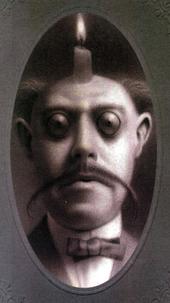Generate your own contact table!
"I will endeavor, of set purpose, to single out, bring together and sum up the elements which have constituted the spirit of the modern movement, in order to extend its sway and impact; and I will endeavor, by way of an attempted refocusing of an encyclopedic character, to disencumber the artistic terrain in order to restore to art in movement its universal scope...
On the other hand I might just have a pint and chill out with some good music..."
The son of a clock-maker of Jurassian and Burgundian descent, The General lived most of hislife in Paris in an eighteenth-century townhouse on the rue Palatine.In 1918 his studies of photochemistry led him to his atom chain reaction theory. This assumedthat once the energy of a quantum has initiated a reaction in which free atoms are formed,these formed atoms can themselves decompose other molecules with the liberation of more freeatoms and so on. The reaction can thus continue for long periods without further outsideinitiations.
The mathematical influence in his work emerged in about 1926, when he was journeying thestratosphere with the Adria Shipping Company. Specifically, he became interested in order andsymmetry. The General described his journey through the stratosphere as "the richest source ofinspiration I have ever tapped."After his journey to the Alhambra, he tried to improve upon the works of the Moors usinggeometric grids as the basis for his sketches, which he then overlaid with additional designs,mainly fruits of a somewhat overactive cornucopia.In his drawings, usually in pen and ink which he sometimes developed further with watercolor,The General did much to create the image most have of Chaos theory in the late 1920s. Hisdraftsmanship was excellent although the works he is best known for adopt a deliberately crudeform of caricature. His oeuvre includes a few absurdist works, such as "Portrait of the Rubbishmen with pearl earings" which has buttons sewn on it, and also includes erotica, such as thedrawings in the World Museum of Erotic Art.
The General was also a claustrophile; he enjoyed small, enclosed spaces. In the first volume ofhis autobiography, he recalls a childhood desire to own a magazine stand in a New York CitySubway station, within which he could enclose himself and listen to the rumble of passingtrains while reading.He was a frequent fixture at science conventions, where he remained friendly and approachable.As noted above, he patiently answered tens of thousands of questions and other mail withpostcards, and was pleased to give autographs. Although he was glad to show his talent, he alsorarely seemed to take himself too seriously.
